|
|
|
Spadin : Sortilin Derived Peptide |
Current antidepressant treatments are inadequate for many individuals, and when they are effective, they require several weeks of administration before a therapeutic effect can be observed. Improving the treatment of depression is challenging. Recently, the two-pore domain potassium channel TREK-1 has been identified as a new target in depression, and its antagonists might become effective antidepressants. In mice, deletion of the TREK-1 gene results in a depression-resistant phenotype that mimics antidepressant treatments. Here, we validate in mice the antidepressant effects of spadin, a secreted peptide derived from the propeptide generated by the maturation of the neurotensin receptor 3 (NTSR3/Sortilin) and acting through TREK-1 inhibition. NTSR3/Sortilin interacted with the TREK-1 channel, as shown by immunoprecipitation of TREK-1 and NTSR3/Sortilin from COS-7 cells and cortical neurons co-expressing both proteins. TREK-1 and NTSR3/Sortilin were colocalized in mouse cortical neurons. Spadin bound specifically to TREK-1 with an affinity of 10 nM. Electrophysiological studies showed that spadin efficiently blocked the TREK-1 activity in COS-7 cells, cultured hippocampal pyramidal neurons, and CA3 hippocampal neurons in brain slices. Spadin also induced in vivo an increase of the 5-HT neuron firing rate in the Dorsal Raphe Nucleus. In five behavioral tests predicting an antidepressant response, spadin-treated mice showed a resistance to depression as found in TREK-1 deficient mice. More importantly, an intravenous 4-d treatment with spadin not only induced a strong antidepressant effect but also enhanced hippocampal phosphorylation of CREB protein and neurogenesis, considered to be key markers of antidepressant action after chronic treatment with selective serotonin reuptake inhibitors. This work also shows the development of a reliable method for dosing the propeptide in serum of mice by using AlphaScreen technology. These findings point out spadin as a putative antidepressant of new generation with a rapid onset of action. Spadin can be regarded as the first natural antidepressant peptide identified. It corresponds to a new concept to address the treatment of depression.
Mazella et al.
PLoS Biol. 2010 Apr 13;8(4):e1000355
We recently reported the isolation and sequencing of sortilin, a new putative sorting receptor that binds receptor-associated protein (RAP). The luminal N-terminus of sortilin comprises a consensus sequence for cleavage by furin, R41WRR44, which precedes a truncation originally found in sortilin isolated from human brain. We now show that the truncation results from cellular processing. Sortilin is synthesized as a proform which, in late Golgi compartments, is converted to the mature receptor by furin-mediated cleavage of a 44 residue N-terminal propeptide. We further demonstrate that the propeptide exhibits pH-dependent high affinity binding to fully processed sortilin, that the binding is competed for by RAP and the newly discovered sortilin ligand neurotensin, and that prevention of propeptide cleavage essentially prevents binding of RAP and neurotensin. The findings evidence that the propeptide sterically hinders ligands from gaining access to overlapping binding sites in prosortilin, and that cleavage and release of the propeptide preconditions sortilin for full functional activity. Although proteolytic processing is involved in the maturation of several receptors, the described exposure of previously concealed ligand-binding sites after furin-mediated cleavage of propeptide represents a novel mechanism in receptor activation.
Munck Petersen et al. EMBO J. 1999 Feb 1;18(3):595-604.
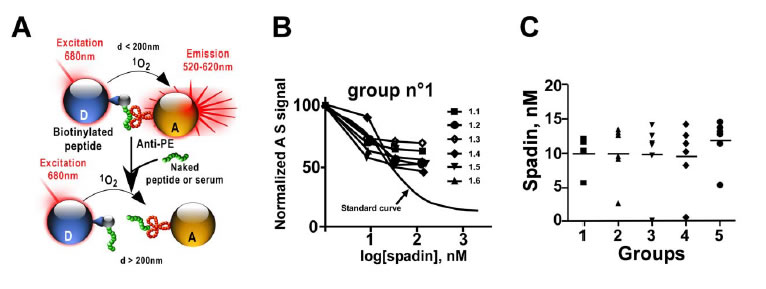
(A) Principles of AlphaScreen technology. Donor and acceptor microbeads can be coated with target-specific antibody, proteins, or secondary reagents (streptavidin, glutathione, nickel). A signal is produced when the AlphaScreen acceptor, A, and donor, D, beads are brought into proximity by a molecular interaction occurring between the binding partners captured on the beads. Laser excitation at 680 nm causes ambient oxygen to be converted to the singlet state by photosynthesizers on the donor bead. These react with chemiluminescent agents on the Acceptor bead only when the latter is in close proximity, emitting light at 520–620 nm. Here, we illustrate a competition protocol between seric propeptide, PE, and interacting donor beads, D, coupled-biotinylated spadin (b-spadin) with antibodies anti-propeptide (anti-PE) coupled on acceptor beads, A. (B) An example of competition curve obtained with one group (n°1) of 6 mice (1.1 to 1.6) among 5 different groups (other curves are presented in the Figure S1). Values obtained are compared to the standard.
Mazella et al.
PLoS Biol. 2010 Apr 13;8(4):e1000355
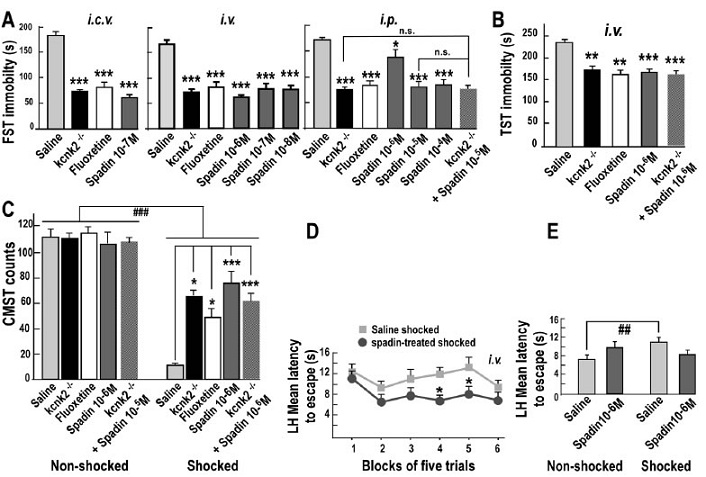
(A–E) Acute treatments: Spadin (10−4 to 10−8 M) or Fluoxetine (3 mg/kg) or Saline solutions were injected 30 min before the test in wild-type and kcnk2−/− mice (A, B, C). (A) Forced Swimming Test (FST, n = = 10 per group), spadin-treated mice had a shorter time of immobility comparable to those obtained with kcnk2−/− or fluoxetine-treated mice, whatever the way of spadin administration: intracerebroventricular (i.c.v., n 10 per group), spadin-treated mice had a shorter time of immobility comparable to those obtained with kcnk2−/− or fluoxetine-treated mice, whatever the way of spadin administration: intracerebroventricular (i.c.v., n = = 14 per group) (one-way ANOVA, F3,55 14 per group) (one-way ANOVA, F3,55 = = 79.53, ***p<0.001 versus saline-treated mice), intravenous (i.v., n 79.53, ***p<0.001 versus saline-treated mice), intravenous (i.v., n = = 8 per group except for fluoxetine and kcnk2−/− groups, n 8 per group except for fluoxetine and kcnk2−/− groups, n = = 6) (one-way ANOVA, F5,43 6) (one-way ANOVA, F5,43 = = 26.27, ***p<0.001 versus saline-treated mice) or intraperitoneal (i.p., n 26.27, ***p<0.001 versus saline-treated mice) or intraperitoneal (i.p., n = = 10 per group except for kcnk2−/−, n 10 per group except for kcnk2−/−, n = = 5 ) (one-way ANOVA, F3,34 5 ) (one-way ANOVA, F3,34 = = 40.58, *p<0.05, ***p<0.001 versus saline-treated mice). (B) Tail Suspension Test (TST, n 40.58, *p<0.05, ***p<0.001 versus saline-treated mice). (B) Tail Suspension Test (TST, n = = 15 for saline and spadin groups, and n 15 for saline and spadin groups, and n = = 9 for fluoxetine and kcnk2−/− groups), i.v. spadin-treated mice had a shorter immobility score comparable to those obtained with kcnk2−/− or fluoxetine-treated mice (one-way ANOVA, F3,47 9 for fluoxetine and kcnk2−/− groups), i.v. spadin-treated mice had a shorter immobility score comparable to those obtained with kcnk2−/− or fluoxetine-treated mice (one-way ANOVA, F3,47 = = 11.40, **p<0.01, ***p<0.001 versus saline-treated mice). (C) Conditioned Motility Suppression Test (CMST, n 11.40, **p<0.01, ***p<0.001 versus saline-treated mice). (C) Conditioned Motility Suppression Test (CMST, n = = 10 per group). Two-way ANOVA showed significant effects of shocks (F1,62 10 per group). Two-way ANOVA showed significant effects of shocks (F1,62 = = 254.1, p<0.001), treatment (F3,62 254.1, p<0.001), treatment (F3,62 = = 3.87, p<0.01) and an interaction between these two factors (F3,62 3.87, p<0.01) and an interaction between these two factors (F3,62 = = 8.83, p<0.001). ###p<0.01 versus non-shocked mice. In the shocked groups, spadin treatment reversed the freezing state induced by the shock training in saline-treated mice (78±7 versus 14±2 counts, respectively). This effect was stronger than those observed for kcnk2−/− or fluoxetine-treated mice (one-way ANOVA, F3,39 8.83, p<0.001). ###p<0.01 versus non-shocked mice. In the shocked groups, spadin treatment reversed the freezing state induced by the shock training in saline-treated mice (78±7 versus 14±2 counts, respectively). This effect was stronger than those observed for kcnk2−/− or fluoxetine-treated mice (one-way ANOVA, F3,39 = = 10,87, *p<0.05, ***p<0.001 versus saline-treated mice). Counts are the number of squares crossed plus the number of climbings. (D and E) Learned Helplessness test (LH, n 10,87, *p<0.05, ***p<0.001 versus saline-treated mice). Counts are the number of squares crossed plus the number of climbings. (D and E) Learned Helplessness test (LH, n = = 12 per group). Shocked spadin-treated mice showed shorter escape latencies than saline-treated mice. Two-way ANOVA showed significant effect for treatment (F1,110 12 per group). Shocked spadin-treated mice showed shorter escape latencies than saline-treated mice. Two-way ANOVA showed significant effect for treatment (F1,110 = = 7.93, p 7.93, p = = 0.01) and for assay (F5,110 0.01) and for assay (F5,110 = = 3.56, p 3.56, p = = 0.005 , *p<0.05 in shocked groups). (D) Mean escape latencies ± SEM averaged in 6 blocks of 5 trials, and (E) mean overall latency ± SEM to escape across trials 1–30 as a function of spadin treatment. Two-way ANOVA (Shocks×Treatment) showed an interaction between these two factors (F1,44 0.005 , *p<0.05 in shocked groups). (D) Mean escape latencies ± SEM averaged in 6 blocks of 5 trials, and (E) mean overall latency ± SEM to escape across trials 1–30 as a function of spadin treatment. Two-way ANOVA (Shocks×Treatment) showed an interaction between these two factors (F1,44 = = 6.9, p 6.9, p = = 0.012). ##p 0.012). ##p = = 0.007 for non-shocked saline-treated mice versus shocked saline-treated mice. 0.007 for non-shocked saline-treated mice versus shocked saline-treated mice.
Mazella et al.
PLoS Biol. 2010 Apr 13;8(4):e1000355
A Vps10p domain makes up the entire luminal part of Sortilin, and this type of domain is the hallmark of a new family of neuronal receptors that target a variety of ligands, including neurotrophins and neuropeptides. We have shown that two structural features of the Vps10p domain, the N-terminal propeptide and the C-terminal segment of ten conserved cysteines (10CC), are key elements in the function of Sortilin. The propeptide has two functions. (i) It binds the mature part of Sortilin and prevents ligands in the biosynthetic pathway from binding to the uncleaved proreceptor, and (ii) it facilitates receptor transport in early Golgi compartments by a mechanism that does not depend on its ability to prevent ligand binding. In contrast, other Vps10p domain receptors, such as SorLA and SorCS3, do not need their propeptide for normal and swift processing. The 10CC segment constitutes an exchangeable module containing five conserved disulfide bridges, and using module-shuffling and truncations, we have shown that the 10CC segment is a major ligand-binding region in Sortilin.
J Biol Chem. 2004 Nov 26;279(48):50221-9. Epub 2004 Sep 10.
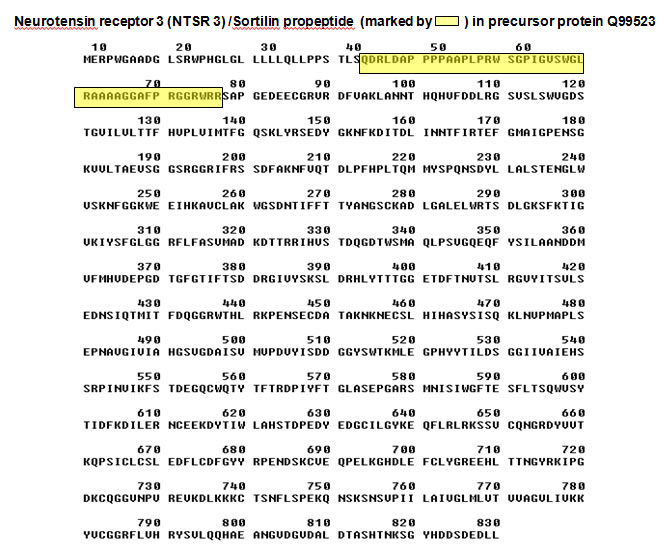
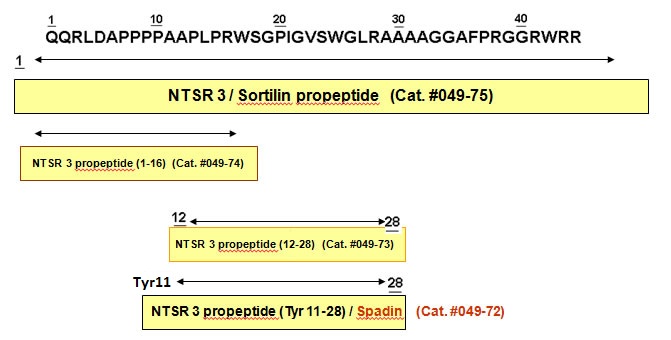
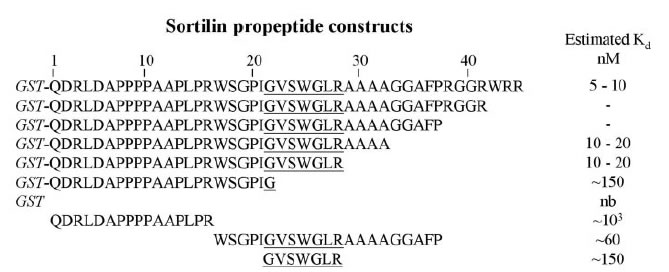
The listed peptides and GST fusion proteins, covering segments or the entire (Gln1-Arg44) sequence of the Sortilin-propeptide, were tested for binding to immobilized s-Sortilin using surface plasmon resonance analysis. The estimated Kd values were determined from response curves obtained at several different concentrations (10 nM–5 uM) of each construct or, in the case of the heptapeptide Gly22-Arg28, assessed by the ability of the peptide to inhibit the interaction between Sortilin and the wild-type propeptide. nb indicates no binding.
J Biol Chem. 2004 Nov 26;279(48):50221-9. Epub 2004 Sep 10.
|
|
|
%049-7%
|
|
|


